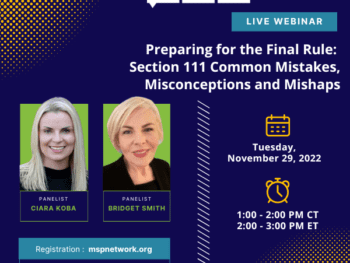
The situation is causing confusion for many in the workers’ compensation system. At the same time, employers and insurers must continue to provide care and process claims for workers with injuries and diseases unrelated to COVID.
The total number of claims in the workers’ compensation system has declined due to the COVID-19 pandemic. Where appropriate, focusing on settlements for legacy claims can free up teams to concentrate on coronavirus and other pressing claims and offer the best opportunities for injured workers.
Two long-time industry experts are partnering for a free webinar to offer their insights and advice for ways to move claims to settlement. A Prescription for Settling Legacy Claims features Dan Anders, Chief Compliance Officer for Tower MSA Partners, and Phil Walls, Chief Clinical Officer of myMatrixx, Wed., May 20, at 2:00 EDT.
Click Link to Access Free PDF Download
“8 ‘Think Outside the Box’ Tactics to Settle Workers’ Comp Claims”
Barriers to Settlement
Injured workers and payers alike often want to settle claims. However, a number of issues may prevent this from happening.
For injured workers, that may include
- Fear of navigating the medical system without the assistance of a claims adjuster and/or nurse case manager
- Concerns about running out of money too quickly
- A lack of understanding of how to comply with government requirements
Among payers, a major concern is identifying which claims are best suited for settlement and when. Issues of unnecessary costs may also present a difficult challenge to overcome. For example, settlements may include expensive prescription medications that the injured worker no longer needs or uses.
“As claims age, the percentage of spend for prescription drugs increases as does the likelihood that the injured worker will become a Medicare beneficiary,” Anders said. “Often, high drug costs pose insurmountable barriers to settlement.”
There are a number of factors that drive up medication costs that can unnecessarily add many thousands of dollars to a settlement. Among them are:
- Brand name instead of generic drugs
- Private-label topicals
- Specialty drugs
- Compounds — yes, they are still seen, especially in older claims
Clinical oversight and interventions are vital to ensure injured workers get the medications they need, without wasting payers’ money.
MSAs
Settling a claim for a worker who is or will soon become a Medicare beneficiary presents another major consideration: the Medicare Set-Aside. This special fund is created to provide money for treatment specifically related to the workplace injury or illness.
Failure to adhere to government requirements can have severe financial repercussions for the injured worker. That is why it is vital to employ the resources of a team with expertise in MSA development.
For example, there are many ‘red flags’ that, while often unnoticed by the untrained person, can result in exorbitant costs and are of no use to the injured worker. Among them are:
- Use of certain medications such as opioids, muscle relaxants, and NSAIDs
- Multiple prescribers of medications
- Prescription history that is inconsistent with the medical records
The Centers for Medicare and Medicaid Services is often consulted for approval of MSAs prior to settlement. While not a requirement, this helps ensure the agency will not later deem the MSA inadequate.
Getting CMS approval for MSAs is a complicated process, fraught with potential landmines. It’s imperative that these are designed and administered correctly.
PBM/MSA Solutions
Experts in pharmacy benefit management and MSAs working in concert can uncover many unnecessary, expensive issues and interventions to develop an appropriate settlement package.
In their upcoming webinar, Anders and Walls will explain in detail
- The plethora of legacy claims and how to use analytics to define and quantify them
- Ways to identify factors driving up Rx costs
- The use of data to identify opportunities for clinical intervention
- How to work effectively with PBM and MSA providers to reduce prescription drug costs and close claims
They will also discuss best practices in medication management that can be employed early in claims to prevent legacy claims
Conclusion
Far too many claims extend endlessly for no valid reason. By using the resources of those whose focus is solely on providing the best medication regime and the most appropriate MSAs, payers and injured workers can see optimal outcomes.

Contact: mstack@reduceyourworkerscomp.com.
Workers’ Comp Roundup Blog: https://blog.reduceyourworkerscomp.com/
©2020 Amaxx LLC. All rights reserved under International Copyright Law.
Do not use this information without independent verification. All state laws vary. You should consult with your insurance broker, attorney, or qualified professional.














